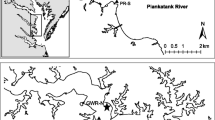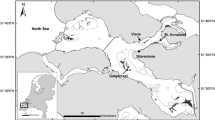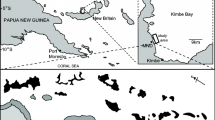Abstract
An analysis of Winslow’s 1878 oyster survey data of Tangier Sound relates the Euclidean dimensions of oyster beds to plan-channel morphology, water depths, bottom slopes, and relief. Results show that at a regional scale the Tangier oyster beds followed a benthic seascape density pattern related to the main axial Tangier Sound Channel: its morphology, meanders, and east-west location. The north-south axis of the channel was intersected by estuarine flows into its central-eastern section, where meanders began with a tight meander around a western shoal, followed by wider second and third meanders. The location of the deepest axial depths of the channel’s bottom indicates a lateral, side-to-side switching between opposite beds, and a vertical undulation in a deepening trend to 31 m at the apex of the first meander. The depth then generally shallowed as the channel plan-form meandered southward to the sound’s entrance. Oyster beds flanked the upper sides of the channel, their generally long and narrow linear axes oriented with that of the main channel in width-to-length ratios of <0.4. Bed lengths increased from the north to the second meander, then decreased. The widest (2.3 km), longest (8.3 km), and largest (7 km2) beds laid opposite each other in the channel’s second meander. Eastern beds were generally wider and larger than western beds, and water depths along their channel sides indicate a deepening trend from 3.6 m in the north to 16.5 m in the south, unlike western beds, which reached a maximum depth of 10.4 m north of the meanders. Minimum water depths on the shoal sides of beds varied little, described by mean values of 4.6 m (SD = 1.1) for eastern beds and 3.3 m (SD = 0.56) for western beds. Analysis of profiles indicates that the deeper southeastern beds had variable relief with longer and more gradual slopes into the channel than the shallower northwestern beds with flatter bed-tops and abrupt, steeper transitions into the channel. The profiles indicate variability of a single bed in distributions of oysters and bed morphologies to make analysis at the small scale difficult. However, at the regional scale, a seascape pattern emerges that relates the distributions of oysters to the channel and shoals. This re-examination of the historic database in the context of regional tidal channel patterns provides parameters for considering the interactive role of oysters with hydrodynamics and the structural importance of oyster reefs for land and seascape processes.
Similar content being viewed by others
Literature Cited
Andrews, J. D. 1979. Pelecypods and lesser classes, p. 293–341.In A. C. Giese and J. S. Pearse (eds.), Reproduction of Marine Invertebrates. Academic Press, New York.
Bahr, L. 1974. Aspects of the structure and function of the intertidal oyster reef. Ph.D. Dissertation, University of Georgia, Athens, Georgia.
Bahr, L. M., Jr. 1976. Energetic aspects of the intertidal oyster reef community at Sapelo Island, Georgia (U.S.A.)Ecology 57: 121–131.
Bahr, L. M. andW. P. Lanier. 1981. The ecology of intertidal oyster reefs of the South Atlantic coast: A community profile. United States Fish and Wildlife Service, Office of Biological Services, Washington D.C. FWS/OBS-81/15.
Baylor, J. B. 1893. Report to the Governor of Virginia in reference to the survey of the oyster grounds. Senate Document Number 11. Richmond, Virginia, p. 1–11.
Carriker, M. R. 1996. The shell and ligament, p. 75–168.In V. S. Kennedy, R. I. E. Newell and A. F. Eble (eds.), The Eastern Oyster,Crassostrea virginica. Sea Grant, College Park, Maryland.
Dame, R. F. 1996. Ecology of Marine Bivalves. CRC Press, Boca Raton, Florida.
Dame, R. F., D. Childers, andE. Koepfler. 1992. A geohydrologic continuum theory for the spatial and temporal evolution of marsh-estuarine ecosystems.Netherlands Journal of Sea Research 30:63–72.
DeAlteris, J. T. 1988. The geomorphic development of Wreck Shoal, a subtidal oyster reef of the James River, Virginia.Estuaries 11:240–249.
Dolan, R., H. Lins, andB. Hayden. 1988. Mid Atlantic Coastal Storms.Journal of Coastal Research 4:417–433.
Fisher, W. S. 1988. Environmental influence on bivalve hemocyte function.American Fisheries Society Special Publications 18: 225–237.
Galtsoff, P. S. 1964. The American oyster,Crassostrea virginica Gmelin.Fishery Bulletin of the United States Fish and Wildlife Service 64:1–480.
Granat, M. A. andJ. C. Ludwick. 1980. Perpetual shoals at the entrance to Chesapeake Bay: Flow-substrate interactions and mutually evasive net currents.Marine Geology 36:307–323.
Grave, C. 1905. Investigations for the promotion of the oyster industry of North Carolina. p. 247–315.In Report of the United States Fish Commission, 1903, Washington, D.C.
Hargis, W. J., Jr. andD. S. Haven. 1995. The precarious state of the Chesapeake public oyster resources. Virginia Institute of Marine Science, Gloucester Point, Virginia.
Haven, D. S., W. J. Hargis, Jr., andP. C. Kendall. 1978. The oyster industry of Virginia: Its status, problems and promise. VIMS Special Papers in Marine Science No. 4. Virginia Institute of Marine Science Sea Grant Program, Gloucester Point, Virginia.
Hedgpeth, J. W. 1953. An Introduction to the Zoogeography of the Northwestern Gulf of Mexico with Reference to the Invertebrate Fauna.Publications of the Institute of Marine Science University of Texas 3:107–224.
Ingersoll, E. 1881. The Oyster Industry. Tenth Census of the United States. The History and Present Condition of the Fishery Industries. Francis A. Walker, Superintendent. Department of the Interior, Washington, D.C.
Keck, R., D. Mauerer, andL. Watling. 1973. Tidal stream development and its effect on the distribution of the American oyster.Hydrobiologia 42:369–379.
Kennedy, V. S. 1996. The ecological role of the eastern oyster,Crassostrea virginica, with remarks on disease.Journal of Shellfish Research 15:177–183
Kidwell, S. M. andD. Jablonski. 1983. Taphonomic Feedback. Ecological Consequences of Shell Accumulation, p. 195–248.In M. J. S. Tevesz and P. L. McCall (eds.), Biotic Interactions in Recent and Fossil Benthic Communities. Plenum Press, New York.
Kuo, A. Y. andK. Park. 1995. A framework for coupling shoals and shallow embayments with marine channels in numerical modeling of coastal plain estuaries.Estuaries 18:341–350.
Larsen, P. F. 1985. The benthic macrofauna associated with the oyster reefs of the James River estuary, Virginia, U.S.A.International Revue der Gesamten Hydrobiological 70:797–814.
Lowrey, T. A. 1992. Apalachicola Bay’s proclivity for sediment export during hurricanes and its impact on oyster production from 1960–1985.Journal Shellfish Research 11:461–466.
McCormick-Ray, M. G. andT. Howard. 1991. Morphology and mobility of oyster hemocytes: Evidence for seasonal variations.Journal of Invertebrate Pathology 58:219–230.
Newell, R. I. E. 1988. Ecological changes in Chesapeake Bay: Are they the result of overharvesting the American oyster,Crassostrea virginica? p. 536–546.In Understanding the Estuary: Advances in Chesapeake Bay Research. Proceedings of a Conference. Chesapeake Research Consortium, Publ. 129. CBP/TRS 24/88.
Oertel, G. F. andA. M. Foyle. 1995. Drainage displacement by sea-level fluctuation at the outer margin of the Chesapeake seaway,Journal of Coastal Research 11:583–604.
O’Neill, R. v., A. R. Johnson, andA. W. King. 1989. A hierarchical framework for the analysis of scale.Landscape Ecology 3:193–205.
Reice, S. R. 1994. Nonequilibrium determinants of biological community structure.American Scientist 82:424–435.
Ridderinkhof, H. andJ. T. L. Zimmerman. 1992. Chaotic stirring in a tidal system.Science 258:1107–1111
Ritter, D. F. 1986. Process Geomorphology, second edition. Wm. C. Brown, Dubuque, Iowa.
Rothschild, B. J., J. S. Ault, P. Goulletquer, andM. Héral. 1994. Decline of the Chesapeake Bay oyster population: A century of habitat destruction and overfishing.Marine Ecology Progress Series 111:29–39.
Secretary of the Interior. 1866. Statistics of the United States in 1860 of the Eighth Census. Government Printing Office, Washington, D.C.
Stanley, J. G andM. A. Sellers. 1986. American oyster. Species Profiles: Life histories and environmental requirements of coastal fishes and invertebrates (Mid Atlantic). Biological Report 82 (11.65), TR EL-82-4. Department of Interior, Washington, D.C.
Stenzel, H. B. 1971. Oysters. Treatise on invertebrate paleontology. Part N, Bivalvia. The University of Kansas and the Geological Society of America, Lawrence, Kansas.
Stevenson, C. H. 1894. The oyster industry of Maryland. Bulletin of the United States Fisheries Commission for 1892, Washington D.C. p. 205–297.
Stølum, H.-H. 1996. River meandering as a self-organization process.Science 271:1710–1713.
Vogel, S. 1994. Life in Moving Fluids, 2nd edition. Princeton University Press, Princeton, New Jersey.
Wang, H. V. C. andS.-Y. Chao, 1996. Intensification of subtidal surface currents over a deep channel in the upper Chesapeake Bay.Estuarine, Coastal and Shelf Science 42:771–785.
Wildish, D. J. andD. D. Kristmanson. 1979. Tidal energy and sublittorial macrobenthic animals in estuaries.Journal of Fisheries Research Board of Canada 36:1197–1206.
Winslow, F. 1882. Methods and results. Report of the oyster beds of the James River, Virginia and of Tangier and Pocomoke sounds, Maryland and Virginia. Government Printing Office, Washington, D.C.
Wright, L. D. 1989. Benthic boundary layers of estuarine and coastal environments.Reviews in Aquatic Sciences 1:75–95.
Wright, L. D., D. B. Prior, C. H. Hobbs, R. J. Bryne, L. C. Schaffner, andM. O. Green. 1987. Spatial variability of bottom types in the lower Chesapeake Bay and adjoining estuaries and inner shelf.Estuarine, Coastal and Shelf Science 10:1–40.
Wright, L. D., R. A. Gammisch, andR. J. Byrne. 1990. Hydraulic roughness and mobility of three oyster-bed artificial substrate materials.Journal of Coastal Research 6:867–878.
Wright, L. D., J. D. Boon, J. P. Xu, andS. C. Kim. 1992. The bottom boundary layer of the bay stem plains environment of lower Chesapeake Bay.Estuarine, Coastal and Shelf Science 35: 17–36.
Yamaguchi, K. 1994. Shell structure and behaviour related to cementation in oysters.Marine Biology 118:89–100.
Author information
Authors and Affiliations
Rights and permissions
About this article
Cite this article
McCormick-Ray, M.G. Oyster reefs in 1878 seascape pattern—Winslow revisited. Estuaries 21, 784–800 (1998). https://doi.org/10.2307/1353281
Received:
Accepted:
Issue Date:
DOI: https://doi.org/10.2307/1353281




